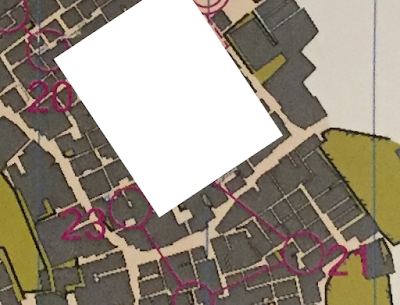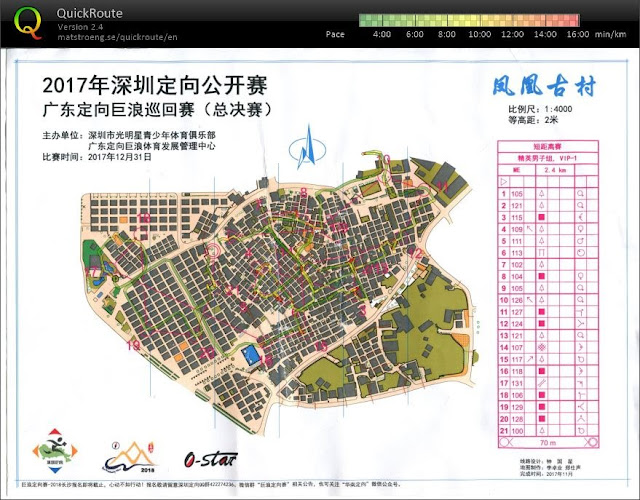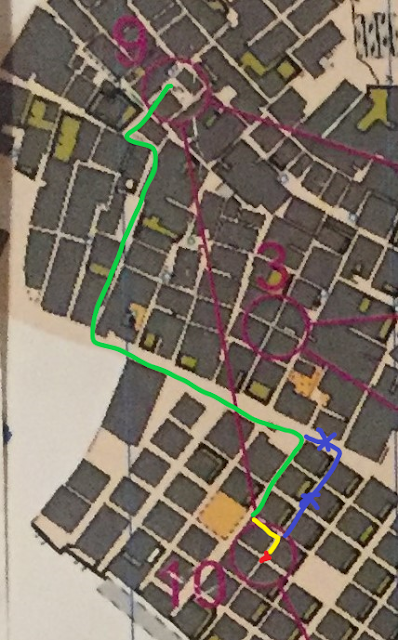My friend said, "how special is that? It is just navigation around buildings."
My reply, "see how similar each building is in the video, and you need to sprint within these forest of buildings."
That was the course that made me amazed on how fun sprint orienteering can be in China.
Today, I signed up a sprint orienteering in China that surpassed the difficulty of the above course. Before starting, I already wanted to say that today's course is not about pure speed, but about who can balance the speed and map reading accuracy. When reading the control description sheet (clue sheet) and seeing so many symbols for buildings, I feel excited that there will be a fun course today. In a sprint orienteering course in China with village terrain, building corners will give a lot of navigational challenges.
| The surrounding areas at the start hinted that today's sprint orienteering course will be in a village terrain, which can be a lot of fun in terms of navigational challenges when running with speed. |
In the end, I read a course that needs mental focus almost everywhere, which is my expectation. This course is probably harder than the one that I showed above, since 1) building pattern is not a simple grid in this map, 2) the pattern is rotated in this map, 3) there are many dead ends.
Field conditions:
To tackle this kind of courses with speed, it is important to apply several orienteering techniques, so that I can simplify the map, and run fast and locate myself accurately:
1) Thumbing and Map Folding:
You do not want to lose track of which alley you are in, and you do not want to make parallel mistakes (two features that are close to each other and look similar, and one confuses one feature with another).
2) 3S - Slow, Set map, Select
a) Slow: when to slow down, how slow (or even complete stop)
b) Set map: needs to do it automatically every time, using the building grid system
c) Select: go forward? move back? turn left? turn right?
3) Decide to do Coarse or Fine Orienteering
a) Coarse orienteering: Control 5-6 -- Go back to the main road (handrail) and run
b) Fine orienteering: Control 6-7 -- Slow down while moving within the alleys, counting intersections and collecting obvious features (e.g. open lands, permanently closed areas, wide paved areas) along the way. These features may also be attack points to the control.
4) Catching Features
A wider alley or road or even a fence at an intersection can be your catching feature to signal that you go too far.
5) Traffic Light
E.g. Control 9 -10
a) Green: run back to the road, turn left, keep running until the road starts to narrow, then turn right, run straight until seeing a wide area
b) Yellow: turn left to go in one row, then turn right
c) Red: look carefully for the control, almost arrive
6) Route choice
Like any sprint courses, which route is shorter? Which route needs many 180-degree turns, which makes you slow down? Which route needs more fine orienteering, which makes you slow down? There are many route choices along this course.
7) Aiming off
E.g. Control 9 - 10
When running on the road, I do not turn right to the correct alley and do not know when the control will pop up (due to so many alleys to count, see figure above, blue line). I turn right one alley earlier, so that I can use the open land to know when I get close to the alley that contains the control, and I know I need to turn left for one block first, and then turn right, since I went one alley earlier.
8) Recovery Technique
At one level, it means when I know I make a mistake of navigation, where I am at. At another level, it is about intentionally not exactly know where I am to gain speed in running, and then find out where I am when I get to a large path or road.
E.g. Control 20 - 21
I may select running back to the wide road to gain speed in running. I can also choose to ignore most features within the village alleys and gain speed by running inside through a more direct route. Then, at obvious feature (e.g. end of T-junction), where I most likely am. I may judge by the length of the blockage (the length of wall between two alleys, or by obvious features around. I find out where I am, and know that when I run to cross the main road, which intersection I am at.
Window training course is the kind of recovery technique that I am thinking. There are "black boxes" between the controls.
 |
| I don't quite care what is inside in the white area. I do need to know where I am when I get to the main road |
The real-time route analysis can be find here:
My biggest mistake is probably Control 1. When waiting to start, while I saw most people running straight, I saw a few ME runners turned left to an alley. I would like to see why, and I did not mind challenging navigation in the beginning, so I tried, and found that this route choice really did not have any advantages. It was too late to change, so I navigate slowly for this control.
There were several areas in the map that can look clearer. Some alleys should be exaggerated a bit to meet to minimum width requirement in orienteering map, so that some important information (e.g., a wall blocking the alley) can be shown. The purple lines for the course should also try to avoid covering the alleys, since it is hard to tell whether the alley can be passable. There are several controls in the later part of the course where straight line route is impossible due to walls and buildings (e.g. Controls 13, 16, 19, 22, and 23).
I did not expect a second place today. I think the true elites can finish 4 minutes faster than me.
After the race, there were lunch around round tables:
I look forward to another village sprint orienteering in China! It is a great place to train orienteering techniques so that one's physical ability to run can be used fully in a sprint orienteering course.

